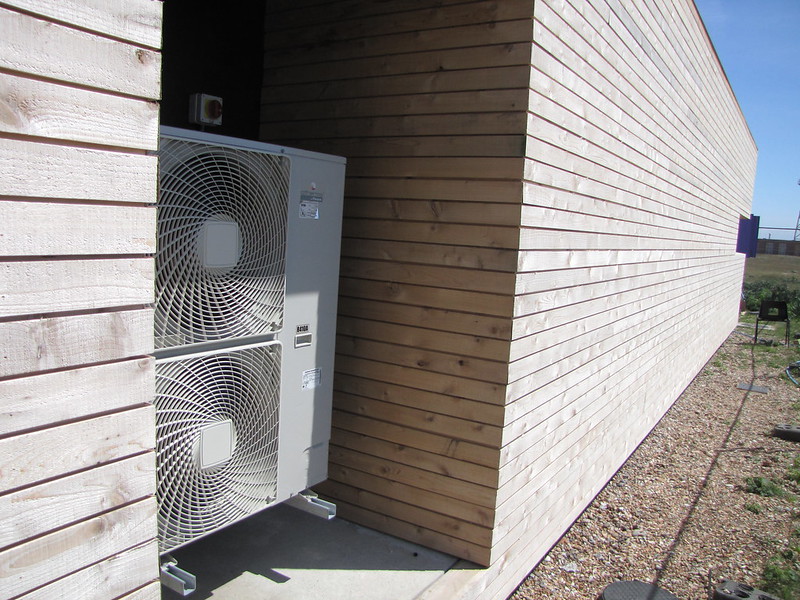An air-to-air heat pump is a highly efficient and cost-effective solution for both heating and cooling homes. It works by extracting heat from the outdoor air and moving it inside through a refrigerant system, even in regions with fluctuating outdoor temperatures. The system consists of an outdoor unit containing the compressor and a fan, and one or more indoor units that can be connected to existing central heating systems or used as a standalone heating and cooling solution.
Understanding the Reversible Refrigeration Cycle
The air-to-air heat pump system utilizes a reversible refrigeration cycle to transfer heat. In the heating mode, the refrigerant absorbs heat from the outside air and releases it inside the building. In the cooling mode, the process is reversed, and the refrigerant absorbs heat from the indoor air and releases it outside.
Key Components of the Refrigeration Cycle
- Compressor: The compressor is the heart of the heat pump system. It is responsible for circulating the refrigerant through the system and increasing its pressure and temperature.
- Condenser: The condenser is the outdoor unit that releases the heat absorbed from the outside air into the indoor space during the heating mode. In the cooling mode, it releases the heat absorbed from the indoor air to the outside.
- Expansion Valve: The expansion valve is a metering device that controls the flow of the refrigerant, reducing its pressure and temperature as it enters the evaporator.
- Evaporator: The evaporator is the indoor unit that absorbs heat from the indoor air during the cooling mode. In the heating mode, it absorbs heat from the outside air.
- Reversing Valve: The reversing valve is a critical component that allows the heat pump to switch between the heating and cooling modes by reversing the direction of the refrigerant flow.
Understanding the Heat Transfer Process
- Heating Mode:
- The compressor increases the pressure and temperature of the refrigerant.
- The hot, high-pressure refrigerant flows to the outdoor condenser, where it releases its heat to the outside air, causing the refrigerant to condense into a liquid.
- The liquid refrigerant then flows through the expansion valve, where its pressure and temperature are reduced.
- The low-pressure, low-temperature refrigerant then flows to the indoor evaporator, where it absorbs heat from the indoor air, causing the refrigerant to evaporate into a gas.
-
The low-pressure, low-temperature gas then flows back to the compressor, completing the cycle.
-
Cooling Mode:
- The process is reversed, with the compressor increasing the pressure and temperature of the refrigerant.
- The hot, high-pressure refrigerant flows to the indoor evaporator, where it releases its heat to the indoor air, causing the refrigerant to condense into a liquid.
- The liquid refrigerant then flows through the expansion valve, where its pressure and temperature are reduced.
- The low-pressure, low-temperature refrigerant then flows to the outdoor condenser, where it absorbs heat from the outside air, causing the refrigerant to evaporate into a gas.
- The low-pressure, low-temperature gas then flows back to the compressor, completing the cycle.
Technological Advancements in Air-to-Air Heat Pumps
The efficiency and performance of today’s air-source heat pumps are a result of various technical advances, including:
- Thermostatic Expansion Valves: These valves provide more precise control of the refrigerant flow, improving the system’s overall efficiency.
- Variable Speed Blowers: Variable speed blowers allow for better temperature and humidity control, as well as increased energy efficiency.
- Improved Coil Design: Advancements in coil design, such as the use of copper tubing with grooved interiors, have increased the surface area for heat transfer, enhancing the system’s efficiency.
- Improved Electric Motor and Compressor Designs: Advancements in electric motor and two-speed compressor designs have led to increased efficiency and reduced energy consumption.
Regulatory Standards and Performance Ratings
Every residential heat pump sold in the United States has an EnergyGuide label, which displays the heat pump’s heating and cooling efficiency performance rating. This allows consumers to compare the efficiency of different makes and models, ensuring they choose the most energy-efficient option for their home.
The efficiency of air-to-air heat pumps is typically measured using the Seasonal Energy Efficiency Ratio (SEER) for cooling and the Heating Seasonal Performance Factor (HSPF) for heating. Higher SEER and HSPF ratings indicate more efficient systems, which can lead to lower energy bills and a smaller environmental impact.
Advantages of Air-to-Air Heat Pumps
Air-to-air heat pump systems offer several advantages, making them a reliable and energy-efficient solution for achieving optimal indoor comfort throughout the year:
- Versatility: The reversible cooling capabilities of air-to-air heat pumps eliminate the need for separate air conditioning units, saving space and money.
- Easy Installation: Air-to-air heat pumps are relatively easy to install, especially when compared to other heating and cooling systems, such as furnaces or boilers.
- Compatibility with Existing Systems: Air-to-air heat pumps can be integrated with existing central heating systems, allowing for a seamless transition.
- Low Maintenance: Air-to-air heat pumps require minimal maintenance, with regular filter changes and occasional cleaning being the primary requirements.
- Safety Advantages: Air-to-air heat pumps do not involve the combustion of fuels, eliminating the risk of carbon monoxide poisoning or other safety concerns associated with traditional heating systems.
By understanding the technical details of how an air-to-air heat pump works, homeowners and HVAC professionals can make informed decisions about the most efficient and cost-effective heating and cooling solutions for their homes.

